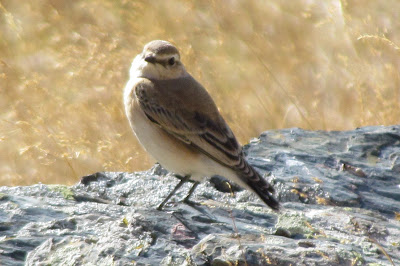Lisbeth and I decided to use our whole day – Saturday – for a walk along the river Tergi into Truso Gorge. Truso gorge and Valley is located on the northern slope of the Caucasus towards Russia, along river Tergi. The Truso gorge and Valley is bordering Russia to the north and the area occupied by Russia/ independent state South Ossetia (Tskhinvali Region in Georgian) to the west. The length of the gorge is 25 km. Truso gorge is also rich in hydrocarbonate mineral waters and one can observe traces of these mineral waters along the whole gorge. Therefore banks of the river Tergi are of various colourings.
According my Guidebook, Peter Nasmyth: Walking in the Caucasus, Georgia from 2006 the valley had been inhabited by Ossetians, who had lived there for centuries.
South Ossetia declared its intention to secede from Georgia in 1990 and, the following year, declared de facto independence. In August 2008 Georgia's efforts to regain control of the area suffered a crippling blow when Russia - the South Ossetian separatists' military backers - defeated a Georgian incursion into South Ossetia in a bloody five-day conflict.
The Ossetians of Truso Valley seems to have been among the people displaced as a result of this conflict, today no people seems to be living in the valley.

We drove to the village Okrokano.

After village Okrokano we walked on a small jeep track along the river in a narrow gorge

Tergi River

After walking in the Tergi Gorge for an hour it opened up and became a valley.

A spring rich in hydrocarbonate, iron and other minerals - like a big bottle of mineral water

Tergi River and in the background Ketrisi Village

Ketrisi Village, Tergi River and some deposits from a mineral spring

Deposits from another mineral spring

Only ruins were left in Ketrisi Village, no inhabitants any more

A police post, no trespassing beyond Ketrisi Village – in the foreground another hiker. In my guidebook from 2006 this hike continues to the next village, and there another hike is described that goes further up the valley – but this possibility is history.

On our way back to Okrokano Village

Tergi Gorge

Tergi River

Okrokano Village – with a military helicopter in the backyard of one of the houses
 Still a lot of cattle grazing in the fields.
Still a lot of cattle grazing in the fields.
 The landscape up to the Chaukhi Mountain was covered with snow and looked very different from my last visit 2 weeks earlier
The landscape up to the Chaukhi Mountain was covered with snow and looked very different from my last visit 2 weeks earlier 
 Donkeys are not so common in the Caucasus compared to horses
Donkeys are not so common in the Caucasus compared to horses  The open pit latrine of one households of the Arabuli family.
The open pit latrine of one households of the Arabuli family. The Ring Ouzel (Turdus torquatus) is a European member of the thrush family Turdidae. It is the mountain equivalent of the closely related Common Blackbird, and breeds in gullies, rocky areas or scree slopes. It breeds in the higher regions of western and central Europe and also in the Caucasus. Most populations are migratory, wintering in the Mediterranean region.
The Ring Ouzel (Turdus torquatus) is a European member of the thrush family Turdidae. It is the mountain equivalent of the closely related Common Blackbird, and breeds in gullies, rocky areas or scree slopes. It breeds in the higher regions of western and central Europe and also in the Caucasus. Most populations are migratory, wintering in the Mediterranean region.














































